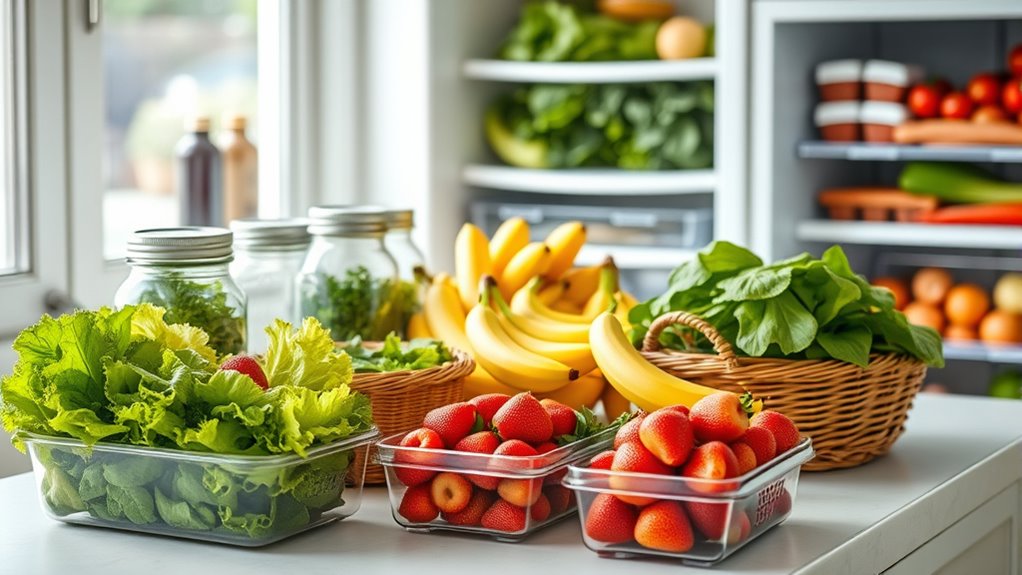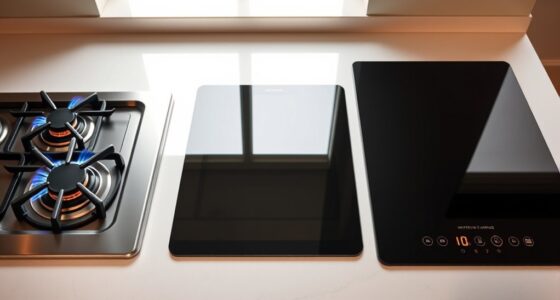To extend the shelf life of fresh produce, start by cleaning fruits and vegetables thoroughly with cold water and drying them completely. Store leafy greens and herbs in perforated bags or ventilated containers, and keep root vegetables in a cool, dark, dry place. Manage temperature and humidity carefully—refrigerate when needed, but keep some fruits at room temperature. Proper ripening, separation of ethylene-producing items, and using appropriate containers can help, so continue exploring for more tips.
Key Takeaways
- Wash produce thoroughly with cold water and dry completely before storage to prevent mold and decay.
- Store ethylene-emitting fruits separately from others to slow overripening.
- Use appropriate containers, such as perforated bags or ventilated containers, for different types of produce.
- Keep leafy greens and herbs in the refrigerator’s crisper drawer with proper humidity control.
- Maintain proper temperature and humidity settings, refrigerating most produce but keeping some at room temperature for better flavor.

Storing fresh produce properly is essential to keep it ripe, flavorful, and safe to eat for as long as possible. When it comes to fruit ripening, understanding how to manage it can make a big difference in extending your produce’s shelf life. Many fruits continue to ripen after harvesting, releasing ethylene gas that accelerates the process. To slow down ripening, keep fruits like bananas, avocados, and tomatoes in a cool, well-ventilated place away from direct sunlight. If you want to speed up ripening, placing these fruits in a paper bag traps the ethylene gas, encouraging faster ripening. This method allows you to enjoy perfectly ripe produce at just the right time without overripe spoilage.
Another critical factor in storing fresh produce is proper produce cleaning. Before storing, always wash fruits and vegetables thoroughly to remove dirt, bacteria, and residual chemicals. Use cold water and, if needed, a gentle brush or cloth to scrub firm produce like potatoes or carrots. For berries and delicate items, a gentle rinse followed by patting dry with a paper towel helps prevent mold and spoilage. Proper cleaning not only improves safety but also preserves quality, allowing your produce to last longer. Ensure you dry produce completely before storage, as excess moisture can promote mold growth and decay. Additionally, using HEPA filtration air purifiers in your storage areas can help reduce airborne mold spores and bacteria that contribute to spoilage.
The way you store different types of produce also matters. Leafy greens and herbs do well in perforated plastic bags or containers with ventilation, which helps maintain humidity while preventing excess moisture buildup. Root vegetables, such as carrots and potatoes, fare best in a cool, dark, and dry place, ideally in a paper bag or breathable container. Fruits that emit a lot of ethylene, like apples and bananas, should be stored separately from other produce to prevent premature ripening and spoilage. Conversely, some fruits like berries should be refrigerated promptly to slow down mold growth, but only after cleaning and drying thoroughly.
Temperature and humidity control are key elements in your produce storage strategy. Refrigeration helps slow down ripening and microbial activity, extending shelf life. However, not all produce benefits from refrigeration; tomatoes and stone fruits, for example, taste better at room temperature. Use crisper drawers for vegetables and herbs, adjusting humidity settings if available. Keep in mind that proper produce cleaning before storage minimizes the risk of contamination and spoilage, ensuring your fruits and vegetables stay fresh longer. By paying attention to ripening cues, cleaning methods, and storage conditions, you can enjoy fresh, flavorful produce for days longer.
Frequently Asked Questions
Can I Store Different Fruits Together Without Affecting Each Other?
You should avoid storing different fruits together because of fruit compatibility issues. Some produce releases ethylene, which speeds up ripening and spoilage of nearby items. To prevent this, use produce separation by storing sensitive fruits separately or in breathable containers. This way, you minimize spoilage, keep your fruits fresh longer, and avoid accidental overripening. Always check specific fruit compatibility before combining different types for ideal freshness.
What’s the Best Way to Store Leafy Greens to Keep Them Crisp?
Think of your leafy greens as delicate dancers needing a gentle stage. Wrap them loosely in a damp paper towel to preserve their leafy freshness, then store in a perforated container or plastic bag to maintain humidity. This method guarantees leafy greens preservation and keeps their crispness maintenance intact. Keep them in the crisper drawer, away from ethylene-producing fruits, to keep your greens fresh and lively longer.
How Does Humidity Affect Produce Shelf Life?
Humidity control plays a vital role in extending produce shelf life because proper moisture management prevents spoilage and dehydration. When humidity levels are too low, produce loses moisture and wilts; too high, and it fosters mold and rot. By maintaining ideal humidity, you help keep fruits and vegetables fresh longer. Adjust humidity settings in your storage areas or use breathable packaging to create the perfect environment for your produce.
Can I Store Produce in the Freezer Without Blanching?
Did you know freezing without blanching can preserve about 80% of produce’s nutrients? You can freeze produce without blanching, but it’s not recommended for long-term storage, as it may affect texture and flavor. Use proper freezing techniques like airtight containers or freezer bags to prevent freezer burn. This method offers a quick way to preserve produce, but for ideal produce preservation, blanching is usually advised to maintain quality.
What Are the Signs of Produce Spoilage I Should Watch For?
You’ll notice produce spoiling when ripening indicators like soft spots or discoloration appear. Watch for mold development, which signals decay and contamination. The produce might emit a sour or foul smell, indicating it’s no longer fresh. Texture changes, such as sliminess or excessive mushiness, are also signs of spoilage. Regularly inspecting your produce helps you catch these signs early, so you can enjoy fresh items and avoid waste.
Conclusion
Storing your fresh produce properly can extend its shelf life considerably—by up to 50% in some cases. Did you know that fruits and vegetables account for about 20% of all food waste globally? By following simple storage tips, you can reduce waste and save money. Keep your produce fresh longer, enjoy better flavors, and make a positive impact on the environment. Start implementing these tricks today and enjoy your healthy, tasty foods for days to come.









